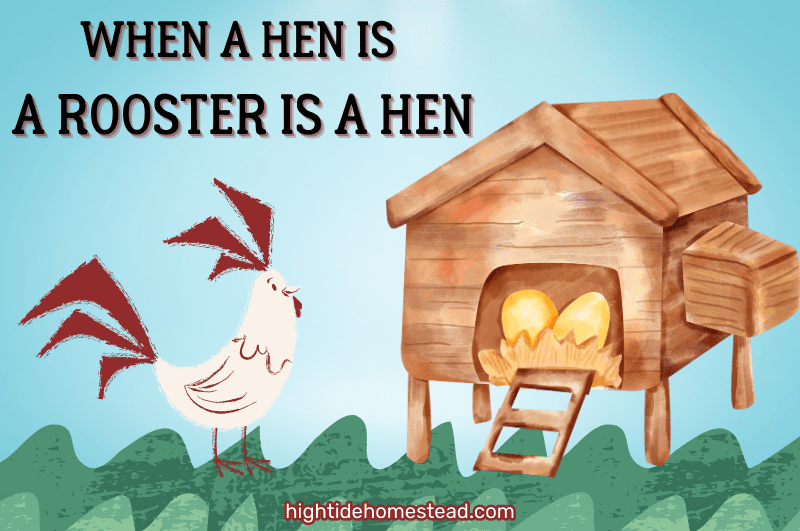High Tide Homestead participates in affiliate programs and may earn commissions from qualifying purchases on this post. See our Disclosure page for more information.
When we started our flock of chickens we had 35, we currently have 8.
Alaska is harsh, our dog, Link, is harsher. We had seven hens, two adult roosters, and one baby rooster until recently, when our adult roosters “The Bobs” disappeared. I mean no trace, just gone. I have no idea what took them, but there have been bears, lynx, coyotes, eagles, and foxes all seen in this vicinity, so any number of predators could be the culprit.
Since our roos absence, one of our hens, Hobbles, has started taking on the characteristics of a rooster. She’s gained a lovely tail, larger and redder comb and wattle, and is now crowing in the mornings!

You can see here that The Bobs, on the left and right, have much bigger tails, combs and wattles than Hobbs in the center.

Hen’s will grow male plumage for two reasons.
Once reason being if there is no rooster around to lead the flock, the hen at the top of the pecking order may start playing the part of a rooster. These hens will sometimes lose the male plumage and return to female coloring after their next molt.
Hens can also become roos if their ovary is damaged (they only have one working one to begin with). With a damaged ovary, hens stop producing enough estrogen (the female hormone), so their body “switches on” the underdeveloped ovary and it turns into a male sex organ called ovotestis. Ovotestis can produce sperm but it is unknown if sperm from a switched roo can actually fertilize an egg. These roosters will never return to hen plumage or lay eggs anymore.
This is a fairly rare occurrence. Some people raise chickens (Amazon) for years and never see it happen. The reverse, a rooster becoming a hen, has also been said to occur as well, and is even more unusual. I’ll be interested to see if Hobbs returns to her female plumage once our baby roo, Agent J, grows up enough to take over the flock!
Bonus picture: Hobbs and Ophelia, who stayed a hen.

High Tide Homestead participates in affiliate programs and may earn commissions from qualifying purchases on this post. See our Disclosure page for more information.

Appreciating the time and effort you put into your site and detailed information you provide.
It’s great to come across a blog every once in a while that isn’t the same outdated rehashed information. Great read!
I’ve bookmarked your site and I’m adding your RSS feeds to my Google account.
Thank you, I’m glad you are enjoying it!
Greetings from the 2nd biggest state in the union. I enjoyed your story. We have a sex role confused bird named Clyde. Before having a similar transformation to your Hobbs, he was Bonnie. Bonnie was a hen who laid an egg every couple of weeks as big as a duck egg and almost always with two yolks. We figured she had a damaged ovary that probably caused the unusual eggs and the transformation.
Thanks for reading, I’m glad you enjoyed this post. I love the name switch for Bonnie and Clyde, that was a great choice! I’m sure your right and damaged ovaries are the cause of Clyde’s switch. I’m surprised s/he was always laying double yolkers though, that’s amazing!